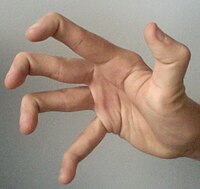
Photo from wikipedia
The prevalence of joint hypermobility (JH) and Joint Hypermobility Syndrome (JHS) in patients with fibromyalgia (FM) is considerable and is much more than can be explained at random(1). Some authors… Click to show full abstract
The prevalence of joint hypermobility (JH) and Joint Hypermobility Syndrome (JHS) in patients with fibromyalgia (FM) is considerable and is much more than can be explained at random(1). Some authors propose that FM and JHS share a common pathophysiological mechanism is some patients. Currently it is accepted that Ehlers-Danlos Syndrome Hypermobility subtype (EDSh) and JHS are the same entity. We regard the subgroup of FM patients with JHS a different subtype of FM, even phenotypically similar to EDSh.Determine the possible differences between both groups according to their body composition, bone metabolism and clinical findings.Our study is observational, descriptive, transverse cohort study in which we included 86 women with fibromyalgia recruited at the Fibromyalgia and Chronic Fatigue Unit at Parc Salut-Mar in Barcelona, Spain. The patients were grouped according to the presence or absence of JHS, following the Brighton Criteria. Diverse clinical data was collected: Pain Visual Analogue Scale (PVAS), time from pain onset, time from diagnosis, somatic symptoms, state of mind, presence of a FM trigger, concurrent medication, anxiety, quality of life, disease impact, anthropometric data, Bioelectrical Impedance Analysis (BIA), bone density test (BMD) and bone metabolism data in blood samples.51 patients were included in the FM group and 35 patients in the FM-JHS group. We did not find differences between groups PVAS; time from pain onset; somatic symptoms using the Psychiatric Disorder and Somatic Pathology Scale (TOPYPS); nor Fibromyalgia Impact Questionnaire (FIQ). Both groups scored similarly on SF-36 Health Questionnaire. The use of opioids was more common in the FM group (p<0,001). Anxiety disorder (AnD) was present in a greater proportion of FM-JHS (p<0,001). We found the Body Mass Index and Muscle Mass (MM) to be less in the FM-JHS group (p=0.001 and p=0.008, respectively). Obesity and fat mass (FatM) were more frequent in the FM group. The FatM and less MM correlated with less quality of life on the SF-36 scale. There was less bone mass (BM) in the FM-JHS group (p=0.005). We found an inverse correlation between the Beighton score and the MM and BM in the FM-JHS group. The FM-JHS group also had less bone mineral density (BMD) at total hip DXA, with significant differences p=0.038. The BM by Bioelectrical Impedance Analysis (BIA) had a positive correlation on the BMD by DXA. The optimum point, capable of distinguishing between normal DXA and osteopenia/osteoporosis was 2,325kg with a specificity of 86% and sensibility of 52%. Vitamin D deficiency/insufficiency was found in 62/84 (73,8%) without significant differences between groups (p>0,05)Our work revealed that FM patients with JHS are different from FM without JHS, by manifesting differences in certain clinical, anthropometric, and bone metabolism features.[1]Lai S, Goldman JA, Child AH, Engel A, Lamm SH. Fibromyalgia, hypermobility, and breast implants. J Rheumatol. 2000;27(9):2237-41.[2]Malfait, F., Francomano, C., Byers, P., Belmont, J., Berglund, B., Black, J., ... & Castori, M. (2017, March). The 2017 international classification of the Ehlers–Danlos syndromes. InAmerican Journal of Medical Genetics Part C: Seminars in Medical Genetics(Vol. 175, No. 1, pp. 8-26).None declared
Journal Title: Annals of the Rheumatic Diseases
Year Published: 2020
Link to full text (if available)
Share on Social Media: Sign Up to like & get
recommendations!